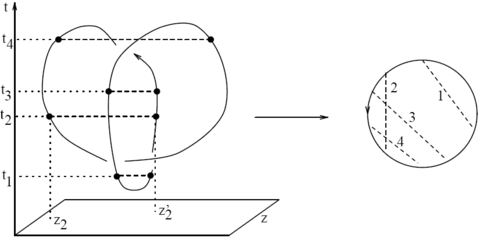07-1352/Class Notes for February 27
| ||||||||||||||||||||||||||||||||||||||||||||||||||||||
Today's Agenda
- Today's material is separately simple and deep, therefore Dror will get the chance to butcher it twice.
- Winding trails in uncharted territories, the problem with black boxes and teleportation, and the pathetic nature of mathematical research.
- Recall the schematics of the Kontsevich Integral.
- Recall the fundamental theorem of finite type invariants for knotted trivalent graphs.
- The underlying basic truth, assuming a "naive" Kontsevich integral for framed trivalent graphs exists.
- A sophisticated construction of the "naive" object, using ideas from renormalization theory and the renormalization group.
- On to the Drinfel'd theory of associators. (Also see the section on parenthesized tangles with the aborted Algebraic Structures on Knotted Objects and Universal Finite Type Invariants).
Today's Lesson
Following today's class I (Dror) have started writing the paperlet The Kontsevich Integral for Knotted Trivalent Graphs.
The Schematics of the Kontsevich Integral
The Fundamental Theorem of Finite Type Invariants for Knotted Trivalent Graphs
Almost Theorem. There exists a universal TG-morphism from the TG-algebra of knotted trivalent graphs to the TG-algebra of Jacobi diagrams. Furthermore, any two such TG-morphisms are twist equivalent.
Theorem. (Essentially due to Murakami and Ohtsuki, [MO]; see also Dancso [Da]) There exists an R-normal TG-morphism from the TG-algebra of knotted trivalent graphs to the -twisted TG-algebra of Jacobi diagrams. Furthermore, any two such TG-morphisms are twist equivalent.
The above theorem is simply the accurate formulation of the almost theorem above it. The "almost theorem" is just what you would have expected, with an additional uniqueness statement. The "theorem" just adds to it a few normalizations that actually make it right. The determination of these normalizations is quite a feat; even defining them takes a page or two. I'm not entirely sure why the Gods of mathematics couldn't have just allowed the "almost theorem" to be true and make our lives a bit simpler.
Enough whining; we just need to define "R-normal" and .
Definition. is called R-normal if Failed to parse (unknown function "\MobiusSymbol"): {\displaystyle Z(\bigcirc)^{-1}Z(\MobiusSymbol)=\exp(\isolatedchord/4)} in , where Failed to parse (unknown function "\MobiusSymbol"): {\displaystyle (\MobiusSymbol)} denotes the positively-twisted Möbius band and where Failed to parse (unknown function "\isolatedchord"): {\displaystyle (\isolatedchord)} denotes the unique degree 1 chord diagram in .
Definition. is almost the same as . It has the same spaces (i.e., for any , ), but the unzip operations on get "renormalized":
- The edge-unzip operations.
- Let denote the specific element of defined in the following subsection. If denotes the unzip operation of an edge for the TG-algebra and is the corresponding operation in , the two operations are related by . Here "" means "inject a copy of on the edge of , and likewise, "" means "inject copies of on the edges and of that are created by the unzip of ".
References
[MO] ^ J. Murakami and T. Ohtsuki, Topological Quantum Field Theory for the Universal Quantum Invariant, Communications in Mathematical Physics 188 (1997) 501-520.






















